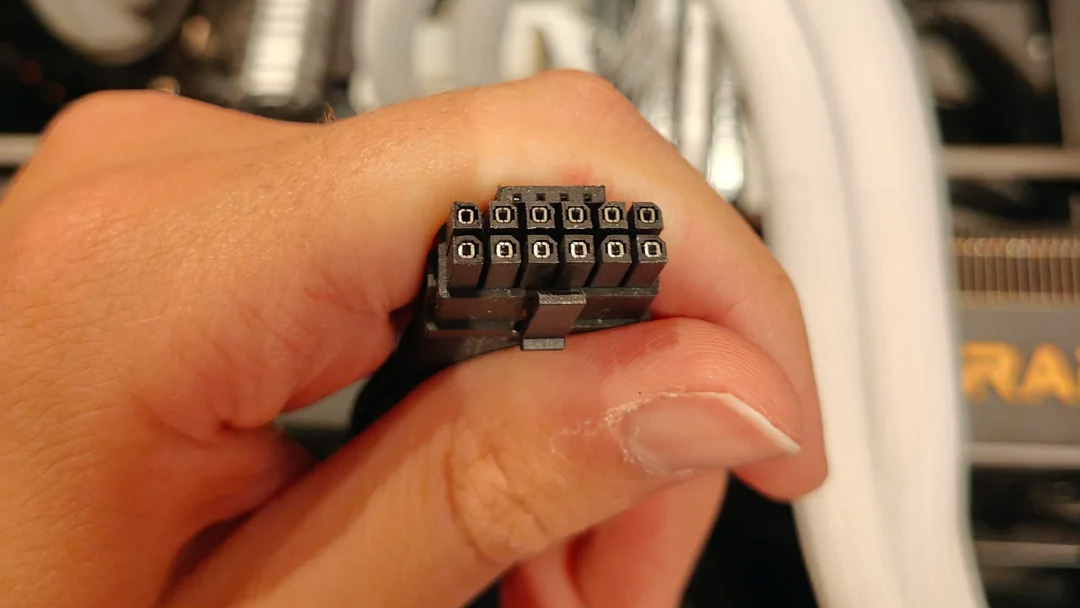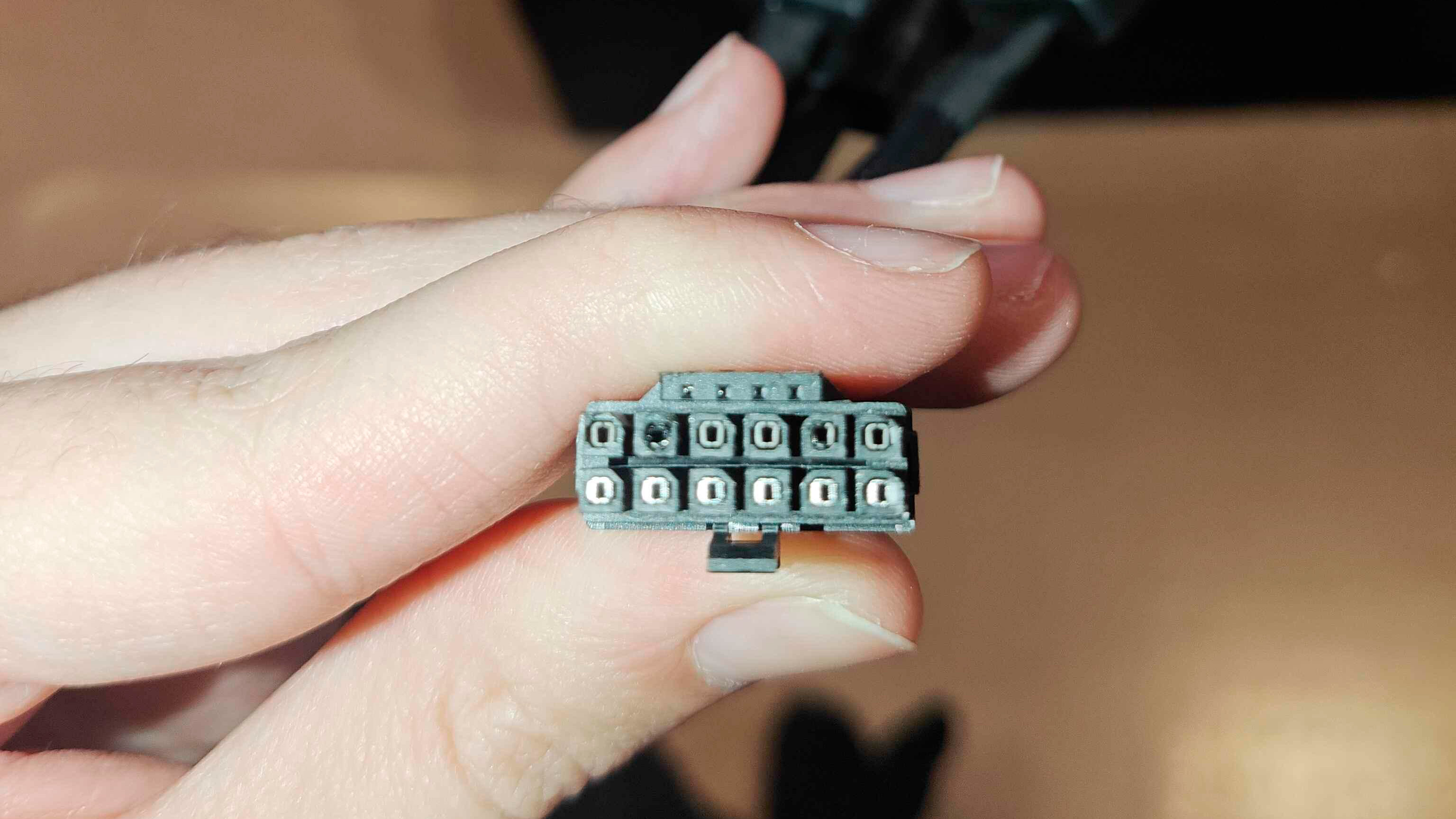AMD zapped with 16-pin power connector melting issue for the first time — Radeon RX 9070 XT paired with sub-par PSU gets singed

The 16-pin (12VHPWR) power connector has experienced meltdowns on some of the best graphics cards. Nevertheless, these unfortunate incidents have predominantly been reported on Nvidia's graphics cards — until now. Reddit user Savings_Opportunity3 has reportedly documented what appears to be the first case of a 16-pin meltdown involving an AMD graphics card.
Not many mainstream AMD graphics cards use the 16-pin power connector. The Radeon RX 9070 XT, leading the AMD Radeon RX 9000-series, is a 304W card that comfortably relies on two standard 8-pin power connectors. Nonetheless, some AMD partners, such as ASRock and Sapphire, have adopted the 16-pin connector for some RDNA 4 models, possibly as a design choice or to differentiate themselves from the competition.
In the case of Savings_Opportunity3, the affected graphics card was a Radeon RX 9070 XT Taichi OC, originating from ASRock's line-up. The same Redditor had posted on Reddit a month ago, asking for advice after noticing discoloration on a few pins inside the 16-pin power connector during a motherboard swap. Fortunately, only one pin from the 16-pin power cable appears to have melted, and the graphics card may have remained functional, as only one pin on the power connector appears darker than the others.


While ASRock doesn't disclose the TDP for the Radeon RX 9070 XT Taichi 16GB OC, the company does recommend users use a power supply with a minimum capacity of 850W. The official recommendation for a reference Radeon RX 9070 XT is a 750W unit; therefore, ASRock's version should pull somewhere between 340W and 360W under regular operation.
Savings_Opportunity3 didn't specify which power supply he was using, but admitted it was "cheap" and a Kolink 700W model, which is inferior to ASRock's and even AMD's recommended capacity. The user believed a 700W unit was sufficient for his build, which is centered around the Ryzen 7 5700X3D. The Redditor also reported experiencing an OCP event once while playing the open beta for Battlefield 6 before the meltdown.
The Kolink 700W power supply isn't an ATX 3.1 unit, so it does not have a native 16-pin power cable. The Redditor was utilizing the 16-pin to three 8-pin adapter included with the Radeon RX 9070 XT Taichi 16GB OC. Given the extent of the damage, which appears to be limited to a single pin, it's plausible that the connector wasn't plugged in correctly, considering the delicacy of the 16-pin power connector. However, it's hard to know for sure. In any event, Savings_Opportunity3 has ordered a Corsair RM850x power supply as a replacement, and we wish the user all the best.
Follow Tom's Hardware on Google News to get our up-to-date news, analysis, and reviews in your feeds. Make sure to click the Follow button.
Get Tom's Hardware's best news and in-depth reviews, straight to your inbox.

Zhiye Liu is a news editor, memory reviewer, and SSD tester at Tom’s Hardware. Although he loves everything that’s hardware, he has a soft spot for CPUs, GPUs, and RAM.
-
mac_angel what's an "OCP event"? I never heard of it. I tried Google and didn't find anything on there either.Reply -
DS426 Wow... like I said, why even chance it on a 9070 series card? Buyers need to avoid these Radeon models with those connectors to let the manufacturers know that this isn't acceptable. Love my Sapphires but c'mon.Reply -
DS426 Reply
Over Current Protectionmac_angel said:what's an "OCP event"? I never heard of it. I tried Google and didn't find anything on there either. -
punkncat Hard to "cast shade" at AMD or that connector when the power supply was both under proper recommended voltage and a poor-quality model. Doesn't really make for much of a story so much as it affirms the advice not to use PSU that are not up to the task.Reply -
DS426 Reply
No, pretty easy to cast shade on this connector that has hundreds of reported failures across different GPU's, connectors, and PSU's. Some folks love to brush it under the carpet because it's occurrence rate is below 1%, but it's orders of magnitude higher than the molex 8-pin; it's an occurrence that should be like winning the multi-billion-dollar lottery, not finding coins on the ground when walking along.punkncat said:Hard to "cast shade" at AMD or that connector when the power supply was both under proper recommended voltage and a poor-quality model. Doesn't really make for much of a story so much as it affirms the advice not to use PSU that are not up to the task.
I'm not calling out AMD as I appreciate that they don't overly lock down their AIB partners; moreover, their reference spec is to use molex 8-pin connectors (and sure enough, they've used this in the marketing... lol, of course, right!?)
An improper PSU is an improper PSU, square and simple. Improper PSU's usually result in stability issues, random shutdowns, etc. -
chaz_music Without a doubt this is a design issue, coming from a power electronic engineer who designs high power and even aerospace power systems. I have been following this and have recognized several issues:Reply
1. Hard paralleling connector pins/sockets is not a good idea unless there are some mitigation to force equal currents on both the 12V wires and the return wires. Despite people imparting their ideas on how simple this is, it actually isn't. Adding into the mix that the contact resistance is heavily affected by moisture and oxidation, it does not help that these GPUs and cables tend to be transported globally by ship, increasing the chance for heavy high oxidation buildup due to moisture. And this is made twice as likely by doubling up the connectors: one on the GPU and one on the PSU.
2. The high pin count connectors that have been chosen do not have enough derating per pin. Some of the Molex pins and sockets show derating to 5.5A per pin in this high of a pin count connector shell. This is despite what the standards group published in their specification page. It appears this is where the error started, with whoever was a part of that steering group. The heat will build highest in the center of the connector and as pins damage, the current will shed to the outside pins over time resulting in a row of damaged pins and melted nylon.
3. The cooling systems utilized in PC systems are not favorable for helping with cable cooling. Most notably is the use of aesthetic cable shrouds or webbing. There is large heat generation in the connector and headers, with not that much in the wires in a healthy design. The connectors are relying on heat conduction into the wiring and PCB to pull heat out. If the wires are covered with a shroud, the cooling effect from the wires is greatly diminished. Add in the aesthetics that the industry has made by including connectors on this cable for the PSU side, and it creates a significant problem: the market wants the aesthetics, but it is bad for the design.
4. There exists a large ground loop within the ATX PSU, motherboard, and the GPU system. This ground loop oddly enough helps keep the return wires from being damaged, as the return current can take an alternate path through the PCIe connector, into the motherboard, and back to the PSU through the ATX connector. This causes a noticeable reduction in return wire damage in the GPU cables, but it exposes the path through the motherboard to damage from unintended high current.
Here are some examples of the 12V side pins being damaged without any damage to the return wires. Note that this is not a scientific collection of data, just my observations that most of the pictures shared have this common failure mode. But there are also many other pictures showing both 12V and return pins damaged, indicating the ease of a manufacturing error stacking up and causing failures. Below, the pictures show that the 12V pins are damaged, and they are right next to the smaller 4 signal pins:
Notice on all of these the 12V wires are only damaged (by the 4 pin signal connectors):
https://cdn.mos.cms.futurecdn.net/uAVyHuRtHVs8iefTFsupNH-650-80.jpg.webp
https://cdn.mos.cms.futurecdn.net/QTebHt45YSd8Nq8oXu54q8-650-80.png.webp
@valthuer (I think this was yours)
https://i.postimg.cc/R0ttdFgj/IMG-8616.jpg
https://cdn.mos.cms.futurecdn.net/ZdZ6MHbJv6MGnR3U9YyKLS-650-80.jpg.webp
https://cdn.mos.cms.futurecdn.net/4VQ6en2uzoE2Nxk47ungiM-650-80.jpg.webp
In the meantime, here are some suggestions for users to reduce failures (no guarantees though):
1. Do not use cabling that has a wiring loom wrapped around it, which acts as to reduce and constrict the airflow. The datasheets are expecting decent wire cooling to draw heat away from the connector housing, i.e., no "pretty" nylon shroud covering the wiring to allow for reasonable convection cooling of the wire. If this loom exists, remove it and allow the wire insulation to convection cool better. The wiring looms should require yet another current derating if you want to use them.
2. The wire is expected to act as a heatsink for the connector pins and sockets. Again this is simple physics. The pin and socket contact points are tiny and much smaller than the wire cross-sectional area. For this reason, suppliers should find a way to use larger wire than is presently being used.
3. Since the pin and socket contact points have gone through oxidation and corrosion before you even install them, you should plug and unplug them several time to knock this oxidation off. Don't get excessive with it because you don't want to create fretting failure by scrapping off too much tin plating. About 3-5 time is great. Make sure the last pass is seated well. Do all of this for both ends (PSU as well).
4. You want to get the heat out of the cabling ends. So mount a fan by the GPU connector if you can, as well as at the PSU connector. The resistance imbalance can occur at both ends!
I hope these suggestions help people while the industry addresses these shortcomings. -
chaz_music ReplyDS426 said:No, pretty easy to cast shade on this connector that has hundreds of reported failures across different GPU's, connectors, and PSU's. Some folks love to brush it under the carpet because it's occurrence rate is below 1%, but it's orders of magnitude higher than the molex 8-pin; it's an occurrence that should be like winning the multi-billion-dollar lottery, not finding coins on the ground when walking along.
I'm not calling out AMD as I appreciate that they don't overly lock down their AIB partners; moreover, their reference spec is to use molex 8-pin connectors (and sure enough, they've used this in the marketing... lol, of course, right!?)
An improper PSU is an improper PSU, square and simple. Improper PSU's usually result in stability issues, random shutdowns, etc.
Yes - the problem here was not the PSU power capacity but the connector system. The old 2x 8pin system was not a great idea on its own, but they made things worse by moving to the 16 pin connector and concentrating the heat in a smaller nylon housing. If you can find the Molex apps notes for these, they will show as you concentrate more and more pins into a power connector, you have to derate the current capacity more and more to compensate. Just for reference, a similar Molex pin that I found with a 9.5A pin rating showed a 5.5A derating for a 16 pin housing. But I honestly don't know if that pin is what is being used here, and for clarity, they could be using a pin/socket system that has more than one set of contact dimples to distribute the current.
This also shows that this is an industry problem, not just Nvidia. The steering group that created this is where things started. Kind of like the earliest days of PoE. There were dragons there, too. -
Sluggotg Reply
OCP stands for "Omni Consumer Products". Events may include cyborgs.mac_angel said:what's an "OCP event"? I never heard of it. I tried Google and didn't find anything on there either. -
artk2219 Another one bites the dust, people should avoid this flawed connector altogether if they get a chance. Unfortunately Nvidia makes that harder by shoving it down every OEM's throat, so of course they'll try to standardize on a connector to save on build costs. This is definitely the wrong connector to standardize on however, and it needs to be replaced.Reply